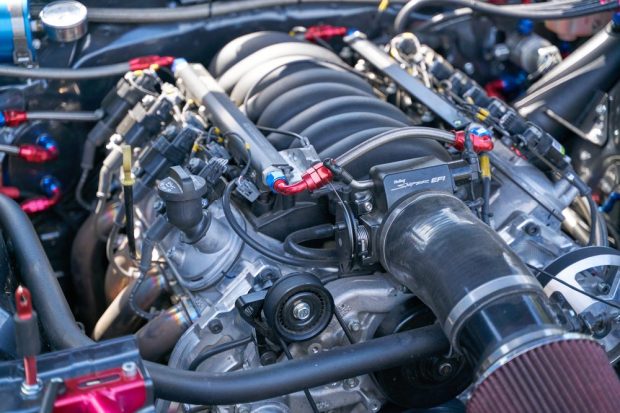CarParts.com CEO Says Data Horsepower Will Drive Disruption in the Auto Aftermarket

When the CV joint on your used car finally breaks, your first thought isn’t how data science and optimized supply chain figure into that repair. But they do, by ensuring that part is readily available and affordable, as the calculus of pouring money into used cars is emotional.
The combination of a data-driven operation that puts the consumer experience first isn’t necessarily what we think of when the auto parts and repair industry comes to mind. Building these out as an e-commerce offering is where the auto parts industry is headed.
“Every other industry out there has a higher digital penetration. If you look at apparel, if you look at electronics, if you look at pet food,” they are all heavily digital, as David Meniane, CEO of CarParts.com told PYMNTS. His company is doing the same for auto parts.
Noting that the average age of a car on the road today is 12.2 years, it’s surprising that the digital shift would happen a bit later for aftermarket auto parts. But Meniane said, “I think one of the reasons it hasn’t been disrupted yet is … there hasn’t been a player to really take it on. The space is very fragmented, and our brick-and-mortar cousins are extremely successful and very comfortable with the way they do business.”
The other reason is fitment, as there are some 14 million SKUs in aftermarket auto parts. That makes cataloging and fitment highly complex, and the reason that CarParts.com has invested heavily in online ordering and fulfillment in what’s turned out to be prescient positioning.
Meniane explained that CarParts.com is recreating the optimal in-store auto parts buying experience online, saying, “You walk to the counter, you say, this is my problem, this is my year, make, and model. And they tell you, here are two options. They don’t give you 150 different options, and they certainly don’t give you options that don’t fit your car. That’s exactly what the catalog does, and that’s the experience that we’re trying to replicate online.”
And since 80% of CarParts.com site traffic is mobile, the company has created a streamlined frontend consumer experience where entering the year, make, and model pulls up the right options and gives the consumer choice in not only parts but payments.
“One of the fastest growing segments on our website is the buy now pay later,” he said. “It is the customer that needs to buy a part, but sometimes is a little bit constrained on cash, especially due to this current environment.” CarParts.com partners with BNPL provider Zip, offering “a risk-free solution for the customer to split the payment over six weeks if they need the part today, but can’t afford it or don’t want to put it on a credit card.”
Data on Wheels
With a massive number of SKUs and permutations on SKUs, Meniane said the auto parts business of 2023 “is 100% a data play. If you look at what we’ve done over the last four years, we’ve made significant investments in data science, data engineering, and advanced analytics. We have five PhDs on the team, and that’s all they do.”
As customers use the site by entering year/make/model and ideally the Vehicle Identification Number (VIN), CarParts.com can use that data to keep aging cars running well while also creating a loyal customer base who can take the DIY route or the ‘do it for me’ path.
“If we want to become a destination for auto repair, we have to take all that data, massage it, and then give it back to the consumer in a way that’s constructive and that creates value for them,” he said. That can take the form of notifications based on the age of a car, its location and the company’s ability to send notifications about what the car may need over time.
That’s how the company is focusing on lifetime value (LTV). “The first transaction is where you establish that relationship with the customer. You create value,” he said. “A big component of the strategy is how do we become a destination, even if that information, even if that connection, doesn’t get monetized? How do we become ’a smart friend’ and provide value for the customer in terms of auto repair, maintenance, and upgrades?”
That friendly frontend experience is backed by a complex data science and logistics operation that manages over 70,000 individual SKUs with precision and first-party insights.
“That’s where the data science comes into play,” he said. “We have an inventory forecasting team that [is] close-knit with the data science team, but they’re all data scientists. It’s how do you take the external data from customers, how do you take the internal data, historical demand, by SKU, by region, by car, and how do you create a forecast for what to stock, and where?”
CarParts.com does it with over one million square feet of fulfillment center space in five distributed fulfillment centers across the U.S., with over 1,000 workers operating 24/7.
The Road Ahead
The investments in data and distribution have supercharged the e-commerce merchant’s performance in recent years, especially during the fraught period of high inflation.
“If you look at our company before we started executing on this strategy, our business was below $300 million, was cash flow negative, and had a lot of debt,” Meniane said. “As we started executing and transforming the business and investing in the key areas — technology, marketing, supply chain, data science — we created a company that last year did more than $660 million in revenue.”
Part of that goes back to catering to the full spectrum of car owners, from those who like to get under the hood to those who barely know how to open the hood. CarParts.com creates content for the DIY enthusiast, but also will “not only will we sell you the part, but we’ll recommend a mechanic. We connect you with that mechanic. We have pre-negotiated pricing, and we can book the appointment for you so that you can buy the part from us and get the job done.”
From here, he said the company is redoubling its focus on convenience, customer service, and deeper online penetration for the aftermarket auto parts sector.
Noting that in just a few years, it’s gone from two fulfillment centers to five, he said, “Over the next couple of years, our goal is to be able to offer one-day transit time or one-day delivery to our customers. What we want is for customers to be able to order from their mobile phones and get the part the next day.”
“Number two is investing in customer experience so that we’re not just selling the parts, but we’re also providing all the information that they need for care, maintenance, upgrades, for performance, just to keep their car running longer. It’s to go from just a parts company to a one-stop destination for auto repair and maintenance,” he said.

